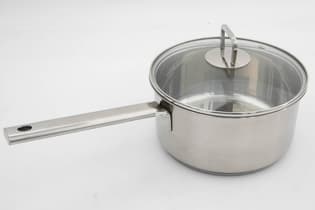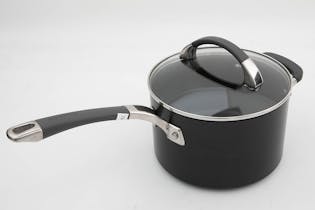Saucepans
We tested 13 saucepans. Which ones hit the spot?
Which saucepans cook evenly and are likely to last? Which are easiest to use and clean? We tested a range of models that are suitable for both induction and regular cooktops.
Best saucepans of 2024
-

Best budget saucepan
-

Best large saucepan
-

Best large saucepan for narrow elements

Get access to Consumer & see all reviews
✔ Personal support through our Consumer Rights Advice Line
✔ Premium articles and in-depth buying advice
✔ Add a Consumer magazine for even more exclusive content
Which type of saucepan is best?
Good saucepans are usually heavier than others because they’re thicker. Thicker models are less likely to warp when heated, so last longer. They distribute heat and cook more evenly, too.
Aluminium saucepans
Non-stick coated saucepans allow you to cook with less oil and are usually easier to clean. But they shouldn’t be used at high temperatures. While non-stick coated saucepans can have a stainless steel body, most are aluminium.
Standard aluminium saucepans are the thinnest and lightest, and the most prone to warping and uneven cooking. Warping can also mean their useful life is short – a flat base is needed for good contact with induction cooktops.
Hard anodised aluminium saucepans are thicker and more resistant to warping than standard anodised or non-anodised pots.
Forged aluminium saucepans are thicker, so they cook better and last longer than standard aluminium models.
Cast aluminium saucepans are another step up. They’re thick and strong and won’t lose their shape. They distribute heat well and cook evenly.
Stainless steel saucepans
Uncoated stainless steel saucepans are conditioned with oil to reduce food sticking when cooking. They can be harder to clean but have a more durable cooking surface than saucepans with non-stick coatings.
The stainless steel is often combined with aluminium in multiple layers to improve heat conduction.
What to consider when buying saucepans
Induction-suitable base: If you want to use your saucepan on an induction cooktop, choose one with a base stated to be induction suitable. It’ll be magnetic – made of ferrous metal. All the saucepans in our test are suitable for induction cooktops, but some models on the market aren’t.
We’ve found that the induction area of some induction-suitable models doesn’t go right to the edge, meaning less even heating and cooking. Check our test results to see which models have a full induction base.
Size: The base of a saucepan should have the same diameter as the element it cooks on. It’ll mean your pot remains stable, is heated evenly and the handle won’t overheat. The measurement printed on packaging is usually for the top opening, not the base. See our test results for accurate base measurements.
Handle safety and comfort: Look for a heat-resistant handle such as one made from Bakelite or phenolic plastic, or one with rubber or silicone grips. Stainless steel can get dangerously hot.
Glass lid: A glass lid lets you keep an eye on what’s cooking without lifting the lid and letting heat escape. The drawback is that glass lids are harder to clean than one-piece lids, catching debris around the rim.
PFOA-free claims: Ignore PFOA-free claims. PFOA (perfluoro-octanoic acid) was previously used in the process of making non-stick cookware coatings (it wasn’t in the coating itself).
It’s been found to build up in the environment and in the human body and has been linked to several adverse health conditions. But, for that reason, it’s no longer used to produce non-stick cookware.
All new saucepans are PFOA-free. But it’s worth noting that manufacturers may use similar chemicals from the same family of substances. The impacts of those chemicals on human health are not yet fully known.
Tips for looking after saucepans
Before using a saucepan for the first time, wash it in warm, soapy water.
Avoid non-stick cooking sprays on cookware with non-stick linings, to prevent damage.
Don’t overheat a saucepan with a non-stick coating. Use only as directed by the manufacturer.
Only add salt to water in your saucepan when it’s boiling or very hot, to prevent pitting of your pot’s cooking surface.
Use heat-resistant nylon, silicone or wooden utensils rather than metal ones. It’ll reduce scratching and damage to any non-stick coating.
Never soak or rinse hot cookware in cold water. It can warp the base and damage non-stick coatings.
Hand-wash your saucepan in warm, soapy water, even if it’s claimed to be dishwasher-safe. Dishwasher detergents can damage non-stick surfaces.
Don’t scrub with a metal scourer – instead, use a soft plastic scrubber or sponge.
Check non-stick surfaces for damage. Replace any cookware with a non-stick coating that’s flaking, peeling or has deep gouges.
Store non-stick cookware separately if possible. If you need to stack with other pots and pans, separate with paper towels to protect non-stick coatings.

.jpg&w=315&q=75)
